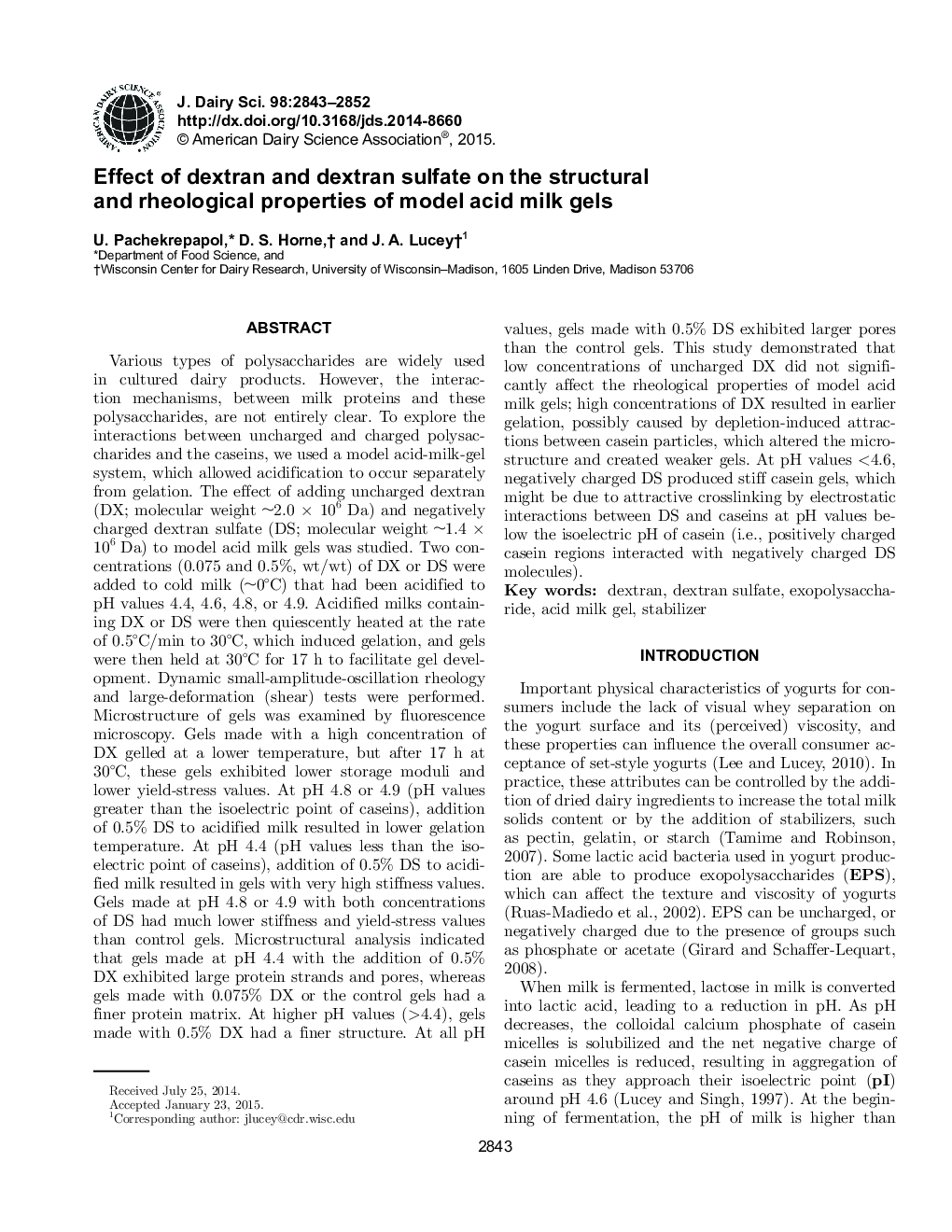| کد مقاله | کد نشریه | سال انتشار | مقاله انگلیسی | نسخه تمام متن |
|---|---|---|---|---|
| 10975475 | 1108034 | 2015 | 10 صفحه PDF | دانلود رایگان |
عنوان انگلیسی مقاله ISI
Effect of dextran and dextran sulfate on the structural and rheological properties of model acid milk gels
ترجمه فارسی عنوان
اثر دکتران و سولفات دکتران بر خصوصیات ساختاری و رئولوژیکی ژل شیر مدل اسیدی مدل
دانلود مقاله + سفارش ترجمه
دانلود مقاله ISI انگلیسی
رایگان برای ایرانیان
کلمات کلیدی
دکستران، سولفات دکتران اگزوپولیساکارید، ژل شیر اسیدی، تثبیت کننده
موضوعات مرتبط
علوم زیستی و بیوفناوری
علوم کشاورزی و بیولوژیک
علوم دامی و جانورشناسی
چکیده انگلیسی
Various types of polysaccharides are widely used in cultured dairy products. However, the interaction mechanisms, between milk proteins and these polysaccharides, are not entirely clear. To explore the interactions between uncharged and charged polysaccharides and the caseins, we used a model acid-milk-gel system, which allowed acidification to occur separately from gelation. The effect of adding uncharged dextran (DX; molecular weight ~2.0 Ã 106 Da) and negatively charged dextran sulfate (DS; molecular weight ~1.4 Ã 106 Da) to model acid milk gels was studied. Two concentrations (0.075 and 0.5%, wt/wt) of DX or DS were added to cold milk (~0°C) that had been acidified to pH values 4.4, 4.6, 4.8, or 4.9. Acidified milks containing DX or DS were then quiescently heated at the rate of 0.5°C/min to 30°C, which induced gelation, and gels were then held at 30°C for 17 h to facilitate gel development. Dynamic small-amplitude-oscillation rheology and large-deformation (shear) tests were performed. Microstructure of gels was examined by fluorescence microscopy. Gels made with a high concentration of DX gelled at a lower temperature, but after 17 h at 30°C, these gels exhibited lower storage moduli and lower yield-stress values. At pH 4.8 or 4.9 (pH values greater than the isoelectric point of caseins), addition of 0.5% DS to acidified milk resulted in lower gelation temperature. At pH 4.4 (pH values less than the isoelectric point of caseins), addition of 0.5% DS to acidified milk resulted in gels with very high stiffness values. Gels made at pH 4.8 or 4.9 with both concentrations of DS had much lower stiffness and yield-stress values than control gels. Microstructural analysis indicated that gels made at pH 4.4 with the addition of 0.5% DX exhibited large protein strands and pores, whereas gels made with 0.075% DX or the control gels had a finer protein matrix. At higher pH values (>4.4), gels made with 0.5% DX had a finer structure. At all pH values, gels made with 0.5% DS exhibited larger pores than the control gels. This study demonstrated that low concentrations of uncharged DX did not significantly affect the rheological properties of model acid milk gels; high concentrations of DX resulted in earlier gelation, possibly caused by depletion-induced attractions between casein particles, which altered the microstructure and created weaker gels. At pH values <4.6, negatively charged DS produced stiff casein gels, which might be due to attractive crosslinking by electrostatic interactions between DS and caseins at pH values below the isoelectric pH of casein (i.e., positively charged casein regions interacted with negatively charged DS molecules).
ناشر
Database: Elsevier - ScienceDirect (ساینس دایرکت)
Journal: Journal of Dairy Science - Volume 98, Issue 5, May 2015, Pages 2843-2852
Journal: Journal of Dairy Science - Volume 98, Issue 5, May 2015, Pages 2843-2852
نویسندگان
U. Pachekrepapol, D.S. Horne, J.A. Lucey,
